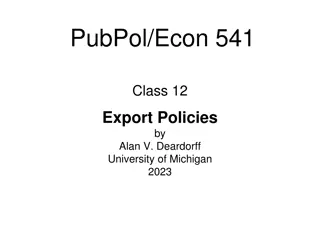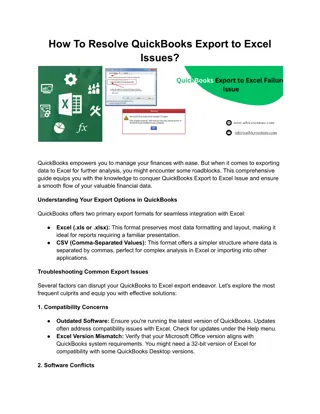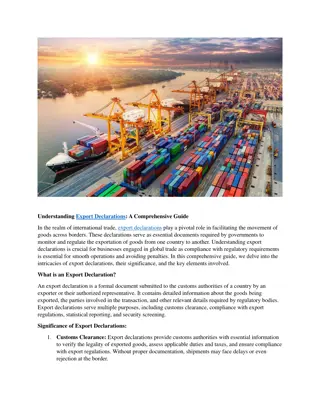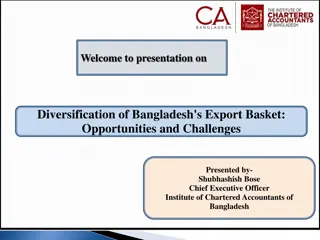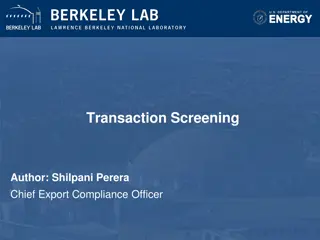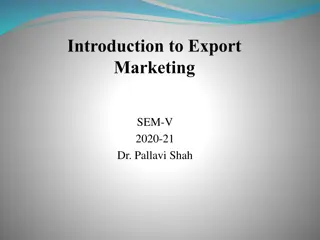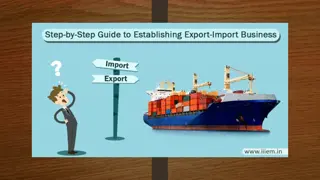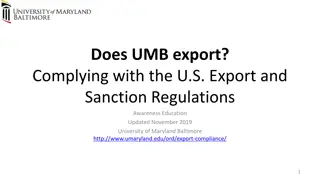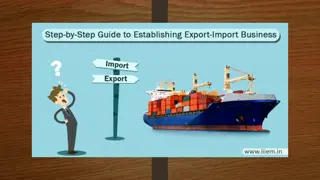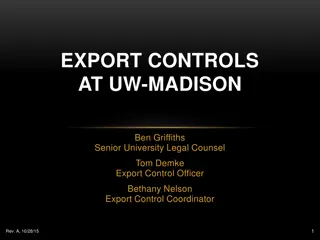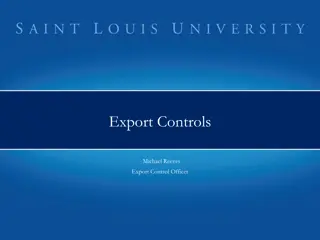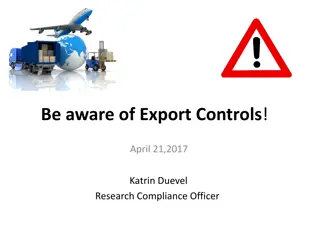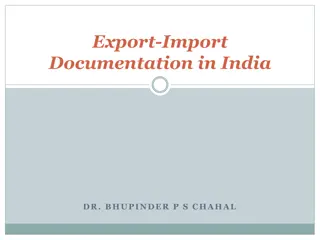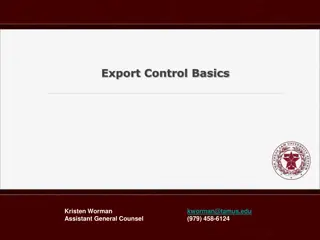Export Priority Focus Area
The Western Cape prioritizes exports for economic growth, facing challenges due to global economic uncertainties. Despite a trade surplus in recent years, obstacles like tariff navigation, resource constraints, and accessing international markets need addressing. Key exports include wine, fresh produce, and petroleum products.
Download Presentation

Please find below an Image/Link to download the presentation.
The content on the website is provided AS IS for your information and personal use only. It may not be sold, licensed, or shared on other websites without obtaining consent from the author.If you encounter any issues during the download, it is possible that the publisher has removed the file from their server.
You are allowed to download the files provided on this website for personal or commercial use, subject to the condition that they are used lawfully. All files are the property of their respective owners.
The content on the website is provided AS IS for your information and personal use only. It may not be sold, licensed, or shared on other websites without obtaining consent from the author.
E N D
Presentation Transcript
Department of Economic Development & Tourism Export Priority Focus Area AGOA key export market Standing Committee 2 June 2023
Background Historically, the Western Cape has adopted an export-oriented approach to development, and this is strongly reflected in the province s current 5-year Plan and the long-standing export promotion efforts of WESGRO. However, exporters in the Western Cape are confronted by multiple constraints, and more must be done to extend existing exports into new markets and to expand the province s export base. G4J has clearly identified exports as a priority focus area (PFA) and work is being done to finalise the Western Cape export strategy which identified and addresses the main constraints confronting the Western Cape and improve the province s export performance. G4J seeks to position exports as a principal means to create jobs, achieve faster economic growth and development; and to raise the contribution of the Western Cape to the country s national trade policy agenda and objectives.
The Western Capes recent trade performance (2011 2022) Trade challenges Current uncertain global economic conditions include the a) Russian invasion of Ukraine, b) the slow Chinese economy's post-pandemic recovery, c) the uncertainties posed by the FED raising interest rates, uncertainty pertaining to AGOA and e) the fluidity of global markets in response to COVID-19-related uncertainties - bilateral trade flows remained relatively strong in 2022. The province's exports amounted to R162.70 billion in 2022, up marginally from R146.39 billion earned in 2021. Imports, in turn, continued their upward trend, increasing slightly to R144.61 billion in 2022, up from R30.61 billion in 2022, up from R30.20 billion in 2021. The province imports significantly more than it exports, though much of this is explained by the large volume of petroleum that is imported through the Western Cape. Excluding petroleum products, the province has returned a trade surplus in four of the last five years. In 2022, wine from fresh grapes was the second largest export from the province, with a value of R10.463. An oil refinery in Cape Town and the country s only gas-to-liquid (GTL) refinery in Mossel Bay are the main facilities in the well-established oil and gas industry of the Western Cape. Fresh produce and Agri-processing exports came in a close third and fourth, with oranges (HS080510) exports earning R8.419 billion (equivalent to 4.5% of total exports) in 2022, followed by apples (HST080810) at a value of R7.206 (3.8%). In parallel, petroleum-related products dominate the province s import basket too, with crude oil and light oil and preparations accounting for a collective for close-on 50% of total import costs incurred in 2022.
Main challenges facing the export environment in the Western Cape Some of the main challenges identified through export analysis which G4J aims to address include: CHALLENGE 3: DIFFICULTIES IN NAVIGATING TARIFFS, STANDARDS AND OTHER REGULATORY BARRIERS CHALLENGE 5: RESOURCE CONSTRAINT CHALLENGE 2: INSUFFICIENT KNOWLEDGE, EXPERIENCE & SUPPLY WHEN IT COMES TO ACCESSING INTERNATIONAL MARKETS CHALLENGE 1: COST & INEFFICIENCY OF TRADE INFRASTRUCTURE CHALLENGE 4: SECURING WESTERN CAPE REPRESENTATION IN NATIONAL PROGRAMMES & POLICIES 1. Exporters must source information on market demand, trends and regulatory requirements; and will usually need to provide samples or undertake sales visits to secure leads and contracts. 2. They must also comply with quality, health, technical and packaging standards, which can differ significantly by country. 3. Governments have an important role to play in reducing the cost of these information gaps and ensuring that exporters have the necessary support. 1. The logistics and infrastructure costs are one of the key impediments to realising the region s trade potential. 2. The available evidence suggests that transport delays and costs are particularly high in South Africa, and this is largely as a result of rail and port inefficiencies & aging infrastructure, as well as the widespread use of road freight. 1. Engagements with stakeholders point to the significant regulatory obstacles and costs encountered by exporters in accessing foreign markets, and a lack of coordinated support across Provincial and National government departments and agencies in navigating trade-related regulations. 1. The Western Cape s export basket often differ from the national norm. 2. Provincial exporters are strongly dependent on the outcomes of national trade negotiations & access to national programmes. 3. PGWC do not have a significant presence in the industry-government dialogue platforms that inform negotiations & national trade interventions. 1. To raise exports and to deepen industrialization, the province will need to diversify into a wider range of products, services and markets. 2. This will require an increase in the province s production capabilities and the development of a new tier of exporters.
Main opportunities for exports from the Western Cape There are undoubtedly positive consequences for those who can adapt, innovate & take advantage of these new circumstances. These opportunities include: OPPORTUNITY 4: AN ESTABLISHED, COMPETITIVE AND ACTIVE EXPORTER & INVESTOR BASE OPPORTUNITY 1: STRONG LINKAGES TO THE GROWING AFRICAN ECONOMY OPPORTUNITY 2: PREFERENTIAL ACCESS TO MOST MAJOR MARKETS OPPORTUNITY 3: A GLOBALLY COMPETITIVE SERVICES SECTOR 1. Services are not only important as key inputs into goods production and exports but have in themselves become an increasingly large contributor to international trade. 2. The Western Cape tourism sector is well developed and is supported by a growing entertainment industry. 3. More recently, the province has become home to emerging BPO, ICT and Greentech hubs. Further possibilities to expand the Western Cape s services exports exist in the design, education and health industries. 1. The African continent presents a myriad of opportunities as local companies seek to grow their global footprint beyond the traditional US and European markets. 2. Notwithstanding the complexities faced when doing business on the African continent 3. Opportunities undoubtedly exist to strengthen South Africa s position as the logistics hub for the continent and a supplier of goods and services to the continent s growing consumer base. 1. South African exporters receive strong preferences in Africa, Europe, the UK and the USA and to a lesser extent in Asia, the Middle East and South America. 2. In 2021, the USA was the largest investor in the Western Cape in value terms, its most important export market and was second only to Germany as a source of overseas tourism. 3. South African exports to the USA continue to benefit from AGOA preferences thought this agreement is subject to renewal in 2025. 1. The private sector in the province is well-capacitated to explore new markets, and through the export councils, well-placed to collaborate with Government to unlock further product and market opportunities. 2. There are also increasing possibilities for the private sector to work with the state in address existing infrastructure constraints, most notably in the energy and transport sectors. 3. This has been supported by the Western Cape Government s efforts to reduce red tape & accelerate the EoDB.
Export Contribution Triple exports from the Western Cape (HOW) The goal is to triple exports by 2035 Goal The value of exports of goods and services (inclusive of tourism) from the Western Cape will be tripled by 2035 Impact 1. Exporting of Goods Contributors 2. Exporting of Services 3. Exporting of Tourism (additional 1 million arrivals)
US Trade Partner response The United States are therefore a strategic trade partner not just for exports but for investment and tourism as well. The Wesgro presentation will provide feedback as it relates to the current trade activity with the US in particular as well as exports under AGOA. Exports will become an even bigger provincial priority for economic growth and the context of the briefing will be in response to that.




